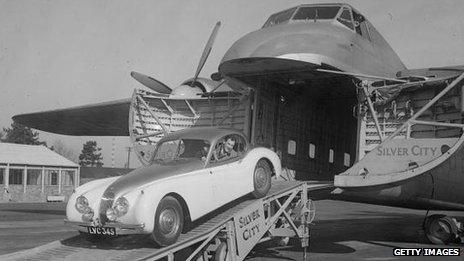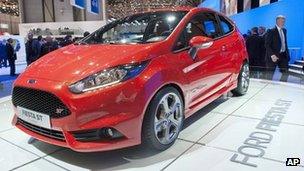Cars roar ahead in Queen's reign
- Published

Motoring was very different in 1952, when Stirling Moss was driving this Jaguar
When the Queen first came to the throne, it was only the sort of people that she might count as friends who could afford a car.
Well, it wasn't quite that exclusive, but you get the idea. The RAC Foundation has come up with some fascinating facts and statistics that show just how motoring has changed over the past 60 years.
The most popular car in 1952 was the Morris Minor, which would have set you back a princely £631, or the equivalent of 20 months' salary (untaxed) for the average worker.
Today's most popular car is the Ford Fiesta, averaging about £9,795, or the equivalent of five months' salary for the average worker.
It's hardly surprising, then, that just one in 20 people owned a car in 1952. Today it's nearer one in two.
What about petrol prices then? Well it was 11d (4.5p) a litre in the early 1950s, which works out at about £1.04 in today's money. Hardly as bad as the £1.40 we're suffering with today, but still not cheap.
Today's most popular cars can also give you 51mpg. Back then, the best seller only managed about 36mpg.

The Ford Fiesta is currently the UK's best-selling car
Surprisingly, road building has been more sluggish than you might imagine. In 1952 there were 185,523 miles of roads.
Today, there are 244,977 miles, but the roads are coping with an extra 30 million cars - most of them, seemingly, on the M6, if my experience is anything to go by.
Driving is much safer today, though. A total of 4,706 people were killed on the roads in 1952. These days it's under 2,000, despite the fact that they are far busier.
The head of the RAC Foundation, Professor Stephen Glaister, talks about a "motoring revolution" since the Queen ascended to the throne.
But one thing that hasn't changed is the reliance on the internal combustion engine. It's been modernised, refined, tweaked, but most of us still burn petrol to get the wheels going.
The next 60 years could prove equally revolutionary. Will it be electric, hydrogen or biofuel engines that finally knock the internal combustion engine off its perch?
It may be all three, or perhaps some mad inventor will emerge from a shed with a fully working teleport machine. You can always dream.